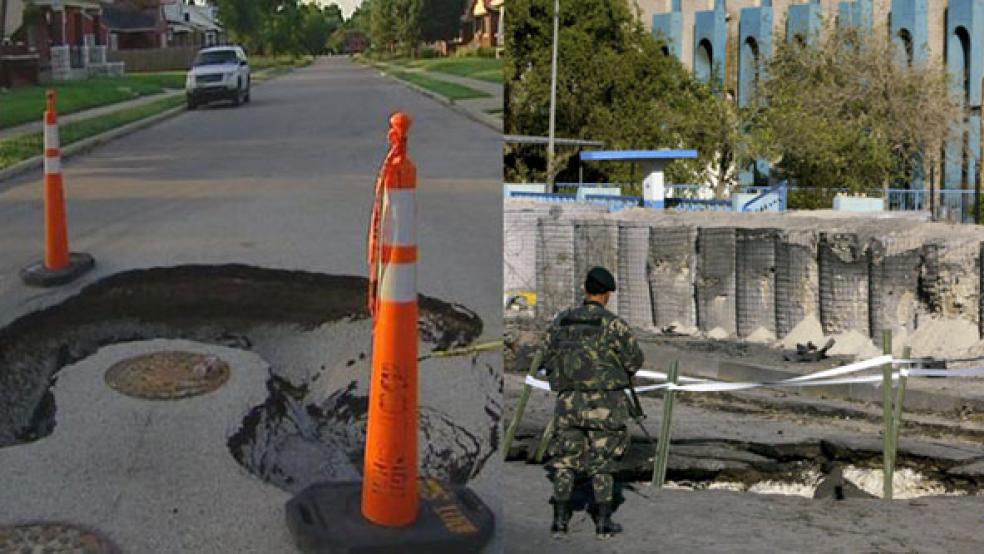All things equal, it would be better for the country to have less debt. Nobody seriously disputes this, but the fact is that all things are not now, and are never really, equal. Today there is a strong argument that it is a wise time to make a strategic investment in U.S. infrastructure by adding to the country’s debt while interest rates remain extremely low.
The World Economic Forum’s Global Competitiveness Report for 2013-2014 ranked the United States a respectable No. 5 in term of overall competitiveness. But our prospects for the future are clouded by an infrastructure ranking that barely cracks the top 20.
RELATED: AMERICA’S THIRD WORLD ROADS—BROKEN AND DANGEROUS
On multiple ratings, the U.S. came out on top in exactly one category: the availability of airline travel. Other than that, rankings on the quality of roads (18th), rail (17th), ports (16th), and other measures show it trailing many of its international competitors.
Earlier this year, the American Society of Civil Engineers issued its annual infrastructure report card, and awarded the U.S. a D+ for infrastructure. You can discount the ASCE’s findings as you please, considering the fact that civil engineers, as a whole, benefit from increased infrastructure spending, but the numbers are hard to argue with.
A few highlights form the report:
n One in four bridges in the U.S. today are either structurally deficient, meaning that their condition has deteriorated to the point that they require annual safety inspections to remain open, or functionally obsolete, which means that they were built to such a low standard that they would be illegal to build today.
n “Almost half of America’s public school buildings were built to educate the baby boomers – a generation that is now retiring from the workforce,” the report found. Meanwhile, annual spending on school construction fell to $10 billion in 2012, down 50 percent from pre-recession levels.
n Congestion alone on U.S. highways costs the economy $101 billion in fuel and lost productivity every year.
RELATED: DOJ’S SPECTRUM “WINNERS” UNDERCUT BIG MONEY AUCTION
This might be excusable if we were taking the necessary steps to upgrade our existing infrastructure, but we’re not, and that’s a real problem.
While comparisons of the federal government to a business or a family are of limited utility – businesses and families, for one, don’t control the money supply – in this case, a simple analogy rings true.
Consider a manufacturing business that has multiple factories, several of which are falling into disrepair. They still function, though the occasional breakdown or equipment malfunction unexpectedly knocks production off track for days at a time at significant cost.
It is perfectly clear to the management of the company that the factories will, at some point or other in the foreseeable future, need to be overhauled.
The company, which has an outstanding credit rating, can borrow cheaply to begin upgrading the factories if it so chooses. If management does so now, in addition to enjoying a low interest rate, it will have more control over the pace of the renovation, meaning that it can limit disruptions to production across the company. It can also hold out for good pricing from contractors, because the work isn’t being done on an emergency basis.
RELATED: BERNANKE’S FINALE: BEGINNING OF THE END OF THE EASY MONEY ERA
To spur the decision, the company’s bankers have given it a warning. In the foreseeable future, interest rates are going to start rising with almost complete certainty. This has nothing to do with the inherent creditworthiness of the company, but is simply a factor of the changing interest rate environment.
Remember that there is no debate over whether the decaying factories need to be refitted. The only question is when.
If management waits, two things are clear: First, the company will pay more, in the form of higher interest rates, for the money it borrows. Second, the company will need to borrow more in the future than it would now, both as a result of inflation, and because factories allowed to fall further into decay cost more to being back to an acceptable state.
While not certain, some other things are at least likely to happen if management delays. The occasional breakdowns in production will become more frequent, as equipment becomes increasingly reliable, resulting in economic losses. When the decision is finally made, the company will have significantly less control over the pace of renovation. Multiple simultaneous renovations under emergency circumstances could create unanticipated production failures, also causing economic losses.
RELATED: CAN CONGRESS COME TOGETHER ON AN INFRASTRUCTURE BILL?
Would you prefer to invest in the company that borrowed cheaply and upgraded judiciously, or the company that waited until circumstance forced it to borrow more money at a higher rate, amid cascading business crises?
To the extent the analogy between a company and a government holds, the United States is in the same position as our imaginary firm. These problems are not theoretical or contingent. They are real, their progression is certain, and we know we are going to have to spend money to fix them. Waiting for an emergency will be expensive – both in terms of money spent and productivity lost.
Right now, the Treasury Department can issue 30-year debt for less than 4 percent interest. But last week, Federal Reserve Chairman Ben Bernanke signaled that economic improvement, slow though it may be, means low rates won’t last forever.
Again, all things being equal, less debt would be better. But things aren’t equal, and our infrastructure is crumbling, which affects competitiveness, production, and GDP. We may not think that we can afford to borrow more at this point. However, it may be closer to the truth to say we can’t afford not to.
Follow Rob Garver on Twitter @rrgarver
Top Reads from The Fiscal Times:




